Home heating advice
How does a hot water cylinder work?
21 Oct 2021 • 8 minutes
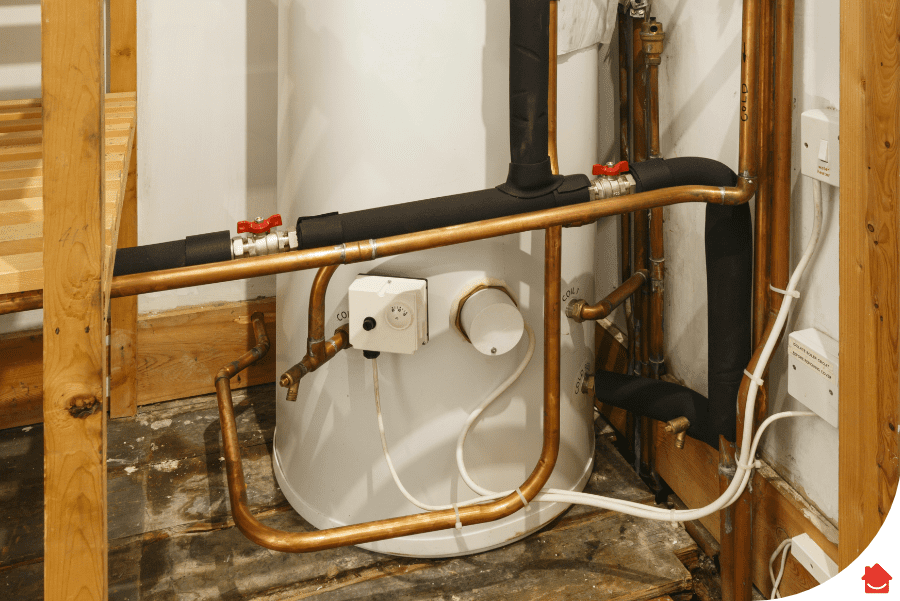

Do you have a hot water cylinder that provides hot water to your taps and shower? If so, it’s an essential component of your central heating system. However, few homeowners and landlords know exactly how hot water cylinders work or how to diagnose potential problems before they become significant ones. So, below is a guide to show you how hot water cylinders work as part of your hot water system.
Hot water cylinders (or as your might call them, hot water tanks) are used in homes to store hot water and keep it warm for that exact moment that you need it.
A hot water cylinder is a tank used for storing hot water to use later. There are two main types of hot water cylinders available in the UK:
Let’s look at both in more detail:
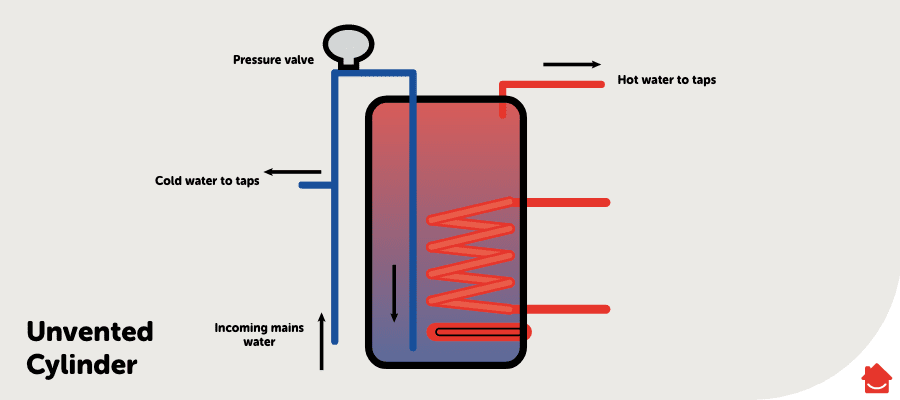
A pressurised unvented hot water cylinder is supplied with water directly from the mains, so it’s supplied with a greater level of pressure than a gravity-based system, which means it can distribute water more easily throughout your home.
Unvented hot water cylinders were first introduced to the UK in the 1980s and one of the reasons for their growing popularity ever since is that they don’t require a separate cold water tank. This makes them more compact than other systems, which take up extra space in your loft or attic. Any work on an unvented hot water cylinder must only be completed by a suitably competent person.
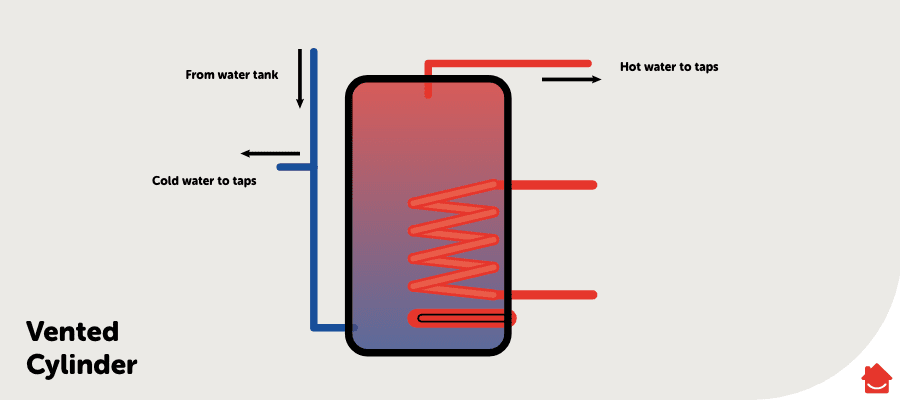
A vented hot water cylinder has its water supplied from the external cold water tank mentioned above. This is also known as a ‘header tank’, and it’s often stored in the attic because it needs gravity to build pressure, rather than having the pressure generated from the mains. It’s called a vented hot water cylinder because a vent pipe is open directly to the atmosphere and any expansion is accommodated through the feed and expansion pipework.
As well as the choice between an unvented or vented hot water cylinder, you can choose whether your hot water system is directly or indirectly heated.
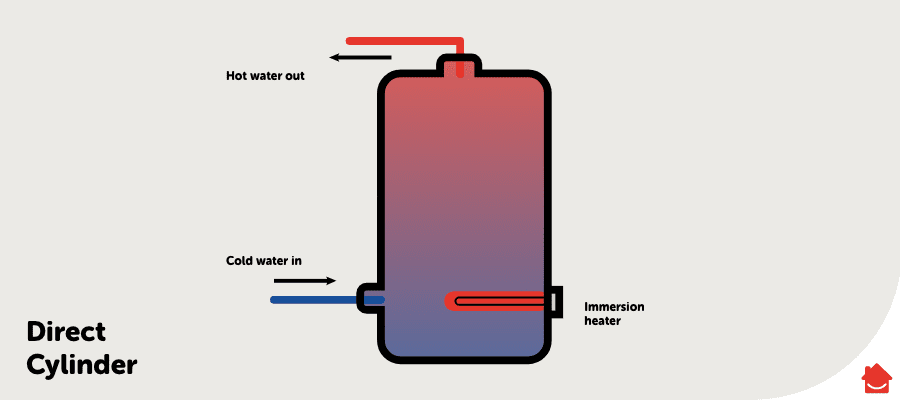
The water in a direct hot water cylinder is heated by an immersion heater within the actual cylinder. This means the cylinder is not connected to a boiler.
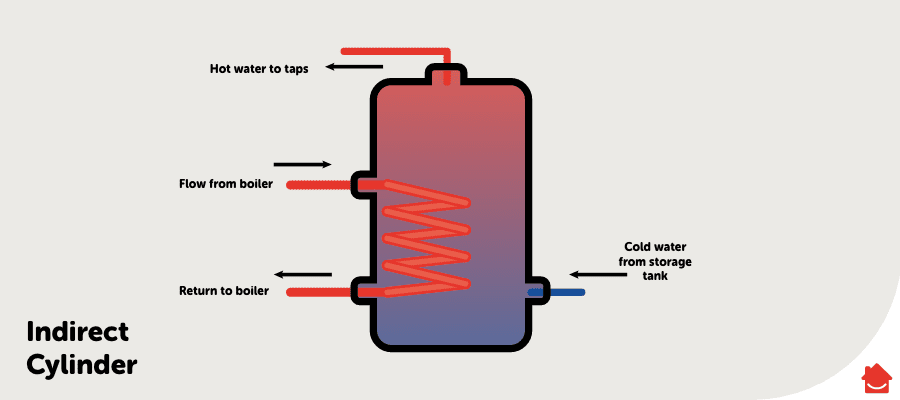
An indirect hot water cylinder needs an external device like a boiler to heat the water through a device called a heat exchanger.
A heat exchanger is any man-made device used to transfer heat. In the case of an indirect hot water cylinder, the heat exchanger is in the form of a heating coil that passes through the inside of the hot water cylinder to heat the water.
Hot water from the boiler passes through the heating coil within the cylinder, transferring its heat to the water inside the cylinder as it passes, but never mixing with the water inside the cylinder. The heat is transferred and the water from the coil comes back around to the boiler to be heated up again.
Ideal for large homes
If you’re the owner or landlord of a larger property with greater demands for hot water, a hot water cylinder is the ideal choice. Combi boilers are perfectly capable of heating water on demand in houses with 1 or 2 bathrooms, they can’t service several taps, showers and radiators being turned on at once.
Hot water cylinders can store large quantities of hot water in advance of being needed. So the system can cope with greater demand.
Versatile and potentially sustainable
A hot water cylinder is a versatile option when it comes to choosing a sustainable fuel source like solar power and biomass fuels. You can also choose to heat it directly with an immersion heater or indirectly with a boiler.
Backup hot water
If you have an indirect hot water cylinder that uses a boiler to heat your hot water, you can add a backup heat source to make sure hot water is available in the event of a boiler breakdown.
Less energy-efficient than a combi boiler system
One disadvantage of a hot water cylinder is that the hot water is heated in advance and is therefore often heated more than is necessary. This means it’s less efficient, and that you’ll have slightly higher energy and water bills as a result.
Limited hot water supply
A hot water cylinder can only hold a finite amount of water before it runs out. It’s certainly large enough to deal with normal daily demand, but if you have lots of guests and demand is too high, the water will run out and the cylinder will take 1 hours to refill.
Less pressure
Vented hot water cylinders use gravity to build pressure for the water, which means that certain parts of the home don’t get as much pressure. Your bathroom shower on the upper floor, for example, will probably receive lower levels of water pressure than your kitchen tap on the ground floor.
Because unvented hot water cylinders operate at a higher pressure than vented systems, they need extra safety features and are therefore more complicated and expensive to install. There are two possible mechanisms for keeping the pressure at a safe level:
Hot water cylinders usually last for about 8-12 years – sometimes even longer if it’s well maintained. Your boiler engineer will be able to carry out comprehensive checks for you to see if the hot water cylinder needs replacing.
A hot water cylinder is usually very hardy and reliable but towards the end of its life you may experience the following signs that it’s time for a replacement:
No hot water
If it’s a direct hot water cylinder, cold water could be a sign that its internal heating element needs replacing. If your cylinder is old (between 8 and 12+ years), it’s a good opportunity to get the whole central heating system checked.
Leaks
Leaks can be very damaging to your home but they can also be a sign of a more serious internal issue with your cylinder.
Strange noises
Just like limescale and sludge builds up in radiators, it also builds up in hot water cylinders over time – especially if you live in a hard water area in the UK, such as London and the South East. Limescale build ups cause blockages, and blockages cause strange noises every time the water in your cylinder is heated. The good news is that a limescale and sludge blockage like this can usually be flushed out by an engineer. However, if left untreated it can cause damage.
If any component of your hot water and central heating system needs looking at, we offer a one-off repairs service to identify and fix any problems. If your boiler can’t be repaired, we’re working with BOXT who offer a speedy boiler installation service so you can get your home back up and running again.
A domestic hot water tank (sometimes called a hot water cylinder) is a tank used for storing hot water in a household for later use.
As a general rule of thumb most hot water cylinders can achieve a reheat time of around 40-60 minutes
Most hot water cylinder manufacturers suggest that the water will lose between 1 kWh and 2.5 kWh of heat per day, which means a 100% full hot water cylinder should stay hot for a day or two. The better insulated your tank is, the more heat it will retain.
Our help & advice articles cover Plumbing, Home heating, Electrical, Energy-saving and Home maintenance.